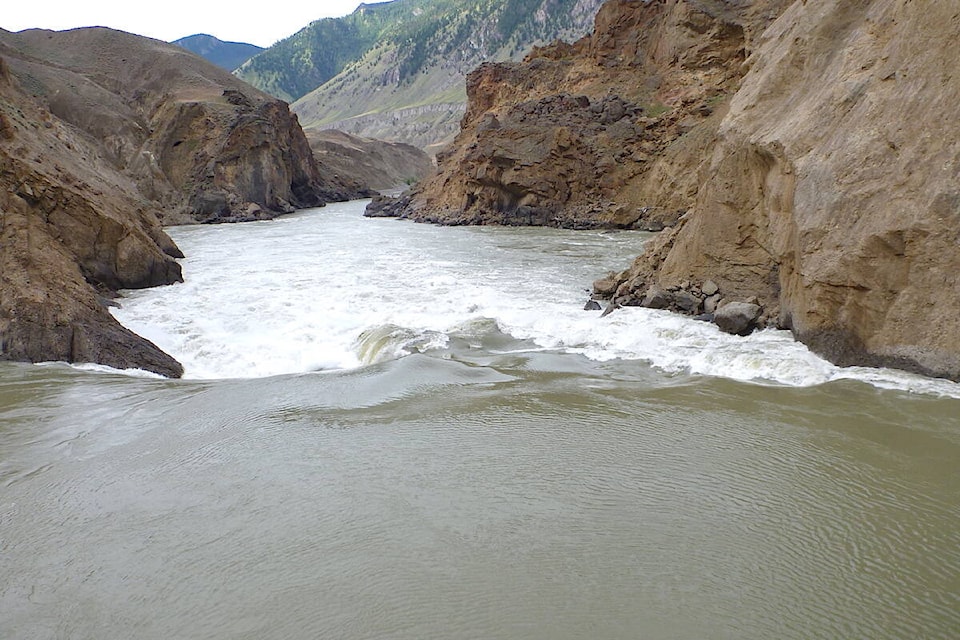Researchers with Simon Fraser University have returned to the scene of a major landslide at Big Bar that blocked the Fraser River four years ago with an eye to mitigating future slides.
The 2018 slide north of Lilooet trapped Fraser salmon runs behind a massive blockage, preventing thousands from reaching their natal streams to spawn, thereby threatening the iconic B.C. species.
ŌĆ£The 2018 landslide raised the issue that I think a lot of people knew might be possible, but no one really thought too much about, that if there was a landslide lower in the Fraser Basin it would wipe out and cause the Fraser salmon to become extinct,ŌĆØ said lead SFU researcher Jeremy Venditti in a May 12 news release.
Venditti, director of SFUŌĆÖs School of Environmental Science, was at Big Bar back in 2009 conducting research.
This spring his research team is once again on-scene at Big Bar comparing measurements to see how the 2018 slide impacted the river in order to predict the likelihood of future extinction-level events.
ŌĆ£We tend to think about landslides as being natural hazards in the sense that they can affect people,ŌĆØ the researcher said. ŌĆ£We donŌĆÖt think of them as the sorts of events that can wipe out populations of plants and animals ŌĆō but they can.ŌĆØ
Remediation efforts to remove the blockage and slide debris, and free the trapped fish saw a co-ordinated effort, with several levels of government joining the battle with an incident command post at Big Bar, including First Nations. It is still ongoing.
At the time several types of fish were believed to be affected by the slide based on the magnitude of the obstruction, including some stocks of concern, officials said. The fish stocks included: Interior Fraser steelhead (Chilcotin), spring/summer chinook, Interior Fraser coho, early Stuart sockeye, early summer sockeye, summer run sockeye and Fraser pinks.
The working hypothesis about the slide was that a massive slab of rock sheared off in June 2018 and slid into a steep and narrow section of the Fraser, creating a five-metre waterfall, and a barrier to fish passage.
The current work of the SFU researchers is part of a larger project aimed at assessing and mitigating the future risk of slides on Fraser salmon. The federal and provincial governments announced funding last summer for the research team but some of the fieldwork was delayed by other slides last fall, further highlighting the ŌĆ£urgency of the project,ŌĆØ Venditti said.
Experts in natural hazards, geomorphology, remote sensing, salmon migration and population genetics will be contributing to the research teamŌĆÖs efforts, along with the inclusion of traditional Indigenous perspectives and oral history.
Possible mitigation ideas could feature engineering solutions, like fishways and fish ladders, which were large structures built at Big Bar during the 2018 crisis to help fish past the blockage, which could possibly be used again to mitigate future slides.
ŌĆ£Our goal is to determine where the next landslide that can threaten salmon is going to happen,ŌĆØ says Venditti. ŌĆ£We enter this understanding landslides, understanding rivers and understanding how fish migrate and have a team thatŌĆÖs excited to conserve and restore Fraser River salmon.ŌĆØ
Partners include researchers from the University of Northern British Columbia, University of Victoria, Durham University, University of Massachusetts Amherst, the Department of Fisheries and Oceans, Fraser Basin Council, the Hakai Institute, Fraser Salmon Management Council and Indigenous communities.
RELATED:
RELATED:
Something to add to this story, or a story tip? Email:
jfeinberg@theprogress.com
Like us on and follow us on .




